This blog entry began as a Twitter thread yesterday. While I enjoy that medium, some may not. This version also provides some further reading for those interested.
And a little bit of background as well:
Music theory has been embroiled in controversy this summer, over the reception of some recent scholarship by music theorist Philip Ewell. You can find Ewell’s excellent work in several forms: a video of his presentation on the plenary session of last fall’s SMT Conference; a blog series in which he serialized many of his ideas, along with additional content; and a substantial article in Music Theory Online published over the summer. Ewell’s work has been, by and large, extremely well received within the field, and many of us have responded to the call to rethink our research and teaching in many ways. One of the notable exceptions was an extremely ill-conceived response from the Journal of Schenkerian Studies, which published a forum of responses to Ewell. With the exception of a few essays that actually engaged in good faith, most of these responses were horrendous: shallow and dismissive at best, viciously racist at their worst. (You can find a brief summary of the incident here, and plenty of other places online; if you’re reading this I assume you know where to look).
OK, now to the twitter essay:
I just carved out some time to really watch Adam Neely’s video, “Music Theory and White Supremacy” attentively. And I think it’s great, an excellent account of Philip Ewell’s work. It really draws together a lot of important ideas from across the field. And though the opening schtick (“the harmonic style of eighteenth-century musicians”) is a tad reductive, I think the video gets better and better as it goes on. It’s an awesome model of longform video argument that makes some potentially arcane material just as legible as the more obvious aspects of this issue. A stellar achievement, Adam!
If you watched very carefully, you might notice that I’m cited in it briefly. I was actually going to re-up that article of mine in response to something else that I recently saw floating around on Twitter, but it turns out there are two reasons to do so now.
Almost precisely two years ago, I wrote an article analyzing the tendencies of “thinkpiece music theory” in outlets like Slate, Vox, etc. Public facing music theory, but written by journalists or guest contributors rather than theorists. While I tried to put a positive spin on things by pointing out that there is actually huge demand for content about music theory, and that more theorists ought to occupy themselves with providing it (two things I really do believe) there are also some troubling things that I identified in this genre.
(I’ll preface this by saying I have no interest in being a gatekeeper - I love to see anyone trying their hand at explaining theoretical concepts or analyzing songs, and there are plenty of awesome creators and writers outside of academic music theory.)
Anyway, as this paper argues, there are at least three common pitfalls that music theory journalism often falls into:
While grounded in actual facts about music, those facts are deployed vaguely, incompletely, or incorrectly. They’re often taken too literally, or perhaps distorted by the game of telephone that seems to happen between the author and whomever they consult with about music. Thinkpiece theory is often grounded in ideas that have filter outwards from academia: either to students, or to popular culture/urban legend more broadly. That is to say, they are grounded in real academic ideas, but often dated or exaggerated versions of how those concepts are understood by scholars. In that way, thinkpiece analyses often re-enact music theory’s historical debates. From another angle—they can sometimes reflect the worst aspects of the discipline, academic music’s worst impulses as filtered through someone who often knows just enough to be dangerous.
Thinkpiece analyses are filled with appeals to authority. It’s how they operate. It might be a scholar. It might be an old historical theory source. More likely, however, it’s a scholar in another field, or even a non-academic: a friend of the author with some musical training, interviewed and quoted like a journalistic source. (I’m serious! You wouldn’t believe how many articles that attempt to analyze songs have a sentence that goes “I wanted to know what was going on, so I called my old college roommate who minored in music. Here’s what they said.”) At the top rung of this prestige ladder is Science, with a capital S but no specificity, because we all know that if you call it science, it’s the ultimate authority. Doesn’t matter if it’s good science or bad, or if it’s even from this millennium. Second only to science is the notion that Music Theory is a monolithic block of knowledge that holds all the answers, on its own terms. But more on that later.
Thinkpiece music theory is made to be passed around: it’s supposed to grab you with its headline, and be quickly digestible so that you’ll send it to friends. It’s even supposed to be shared by other news outlets. Digital scholars call this process “churnalism.” Not only are popular articles (or YouTube videos, for that matter) meant to be retweeted or otherwise shared; they are also fodder for other publications. One outlet publishes the article, and a dozen others write “stories” about the article. They might block quote it or give a few choice excerpts, but they basically exist to grab some traffic based on the headline, and then link to the real thing. Then a dozen blogs start to pass the stories around, etc., and so on.
So, the passage quoted by Adam Neely is one of the case studies that I quote in my attempt to problematize the whole framing “using music theory” in a series of Slate articles, that analyze the music of popular artists like Katy Perry and Lady Gaga. I think the framing of music theory as a secret decoder ring for musical insight, an objective lens that will grant you truth or evaluate the quality of a piece of music, is *very* problematic, whether it’s carried out by a PhD holding theorist, a conservatory-trained musician, a journalist, or a random person on the street. As I say all the time to my students, “There is no such thing as music theory. There are many theories, about many musics.” [I think I owe that quote to my colleague Kris Shaffer]. Or, as my PhD advisor Suzie Clark says, “Music theory is something that people made up, in order to talk about music…which people also made up.” And while I stopped short of describing this as racist when I wrote that paper two and a half years ago, I do call out the framing of the “excellence and supremacy of music theory,” and critique the specific language used in the Gaga analysis, which attempts to re-inscribe the division between the mind and the body, in order to denigrate the latter: a framing I got from Susan McClary and Suzanne Cusick, et al. I’m proud to have my article cited in this exemplary piece of public music theory.








